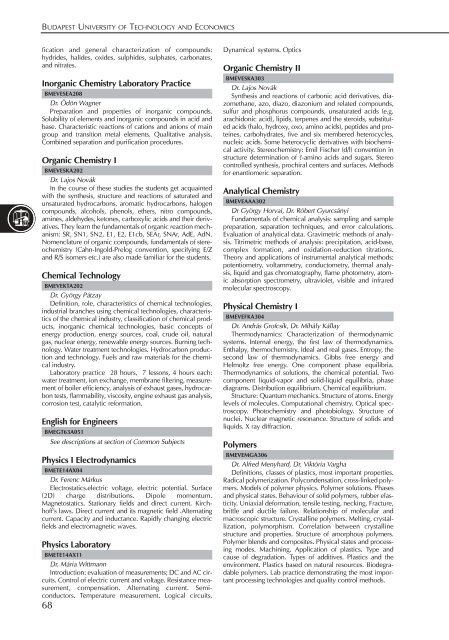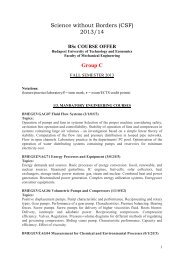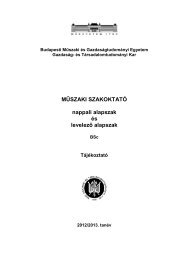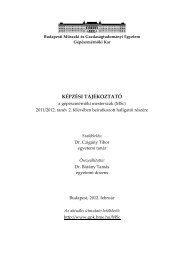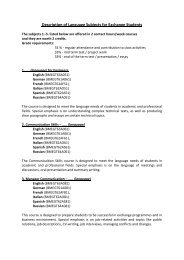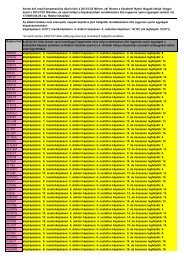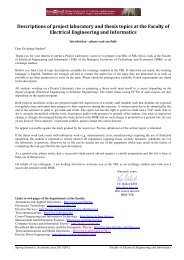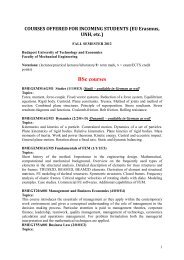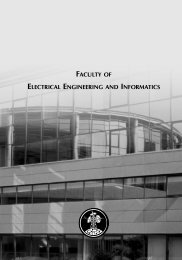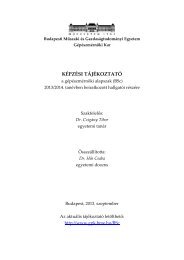FACULTY OF CHEMICAL TECHNOLOGY AND BIOTECHNOLOGY
FACULTY OF CHEMICAL TECHNOLOGY AND BIOTECHNOLOGY
FACULTY OF CHEMICAL TECHNOLOGY AND BIOTECHNOLOGY
You also want an ePaper? Increase the reach of your titles
YUMPU automatically turns print PDFs into web optimized ePapers that Google loves.
BUDAPEST UNIVERSITY <strong>OF</strong> <strong>TECHNOLOGY</strong> <strong>AND</strong> ECONOMICSfication and general characterization of compounds:hydrides, halides, oxides, sulphides, sulphates, carbonates,and nitrates.Inorganic Chemistry Laboratory PracticeBMEVESEA208Dr. Ödön WagnerPreparation and properties of inorganic compounds.Solubility of elements and inorganic compounds in acid andbase. Characteristic reactions of cations and anions of maingroup and transition metal elements. Qualitative analysis.Combined separation and purification procedures.Organic Chemistry IBMEVESKA202Dr. Lajos NovákIn the course of these studies the students get acquaintedwith the synthesis, structure and reactions of saturated andunsaturated hydrocarbons, aromatic hydrocarbons, halogencompounds, alcohols, phenols, ethers, nitro compounds,amines, aldehydes, ketones, carboxylic acids and their derivatives.They learn the fundamentals of organic reaction mechanism:SR, SN1, SN2, E1, E2, E1cb, SEAr, SNAr, AdE, AdN.Nomenclature of organic compounds, fundamentals of stereochemistry(Cahn-Ingold-Prelog convention, specifying E/Zand R/S isomers etc.) are also made familiar for the students.Chemical TechnologyBMEVEKTA202Dr. György PátzayDefinition, role, characteristics of chemical technologies,industrial branches using chemical technologies, characteristicsof the chemical industry, classification of chemical products,inorganic chemical technologies, basic concepts ofenergy production, energy sources, coal, crude oil, naturalgas, nuclear energy, renewable energy sources. Burning technology.Water treatment technologies. Hydrocarbon productionand technology. Fuels and raw materials for the chemicalindustry.Laboratory practice 28 hours, 7 lessons, 4 hours each:water treatment, ion exchange, membrane filtering, measurementof boiler efficiency, analysis of exhaust gases, hydrocarbontests, flammability, viscosity, engine exhaust gas analysis,corrosion test, catalytic reformation.English for EngineersBMEGT63A051See descriptions at section of Common SubjectsPhysics I ElectrodynamicsBMETE14AX04Dr. Ferenc MárkusElectrostatics.electric voltage, electric potential. Surface(2D) charge distributions. Dipole momentum.Magnetostatics. Stationary fields and direct current. Kirchhoff'slaws. Direct current and its magnetic field .Alternatingcurrent. Capacity and inductance. Rapidly changing electricfields and electromagnetic waves.Physics LaboratoryBMETE14AX11Dr. Mária WittmannIntroduction: evaluation of measurements; DC and AC circuits.Control of electric current and voltage. Resistance measurement,compensation. Alternating current. Semiconductors.Temperature measurement. Logical circuits.68Dynamical systems. OpticsOrganic Chemistry IIBMEVESKA303Dr. Lajos NovákSynthesis and reactions of carbonic acid derivatives, diazomethane,azo, diazo, diazonium and related compounds,sulfur and phosphorus compounds, unsaturated acids (e.g.arachidonic acid), lipids, terpenes and the steroids, substitutedacids (halo, hydroxy, oxo, amino acids), peptides and proteines,carbohydrates, five and six membered heterocycles,nucleic acids. Some heterocyclic derivatives with biochemicalactivity. Stereochemistry: Emil Fischer (d/l) convention instructure determination of ?-amino acids and sugars. Stereocontrolled synthesis, prochiral centers and surfaces. Methodsfor enantiomeric separation.Analytical ChemistryBMEVEAAA302Dr György Horvai, Dr. Róbert GyurcsányiFundamentals of chemical analysis: sampling and samplepreparation, separation techniques, and error calculations.Evaluation of analytical data. Gravimetric methods of analysis.Titrimetric methods of analysis: precipitation, acid-base,complex formation, and oxidation-reduction titrations.Theory and applications of instrumental analytical methods:potentiometry, voltammetry, conductometry, thermal analysis,liquid and gas chromatography, flame photometry, atomicabsorption spectrometry, ultraviolet, visible and infraredmolecular spectroscopy.Physical Chemistry IBMEVEFKA304Dr. András Grofcsik, Dr. Mihály KállayThermodynamics: Characterization of thermodynamicsystems. Internal energy, the first law of thermodynamics.Enthalpy, thermochemistry. Ideal and real gases. Entropy, thesecond law of thermodynamics. Gibbs free energy andHelmoltz free energy. One component phase equilibria.Thermodynamics of solutions, the chemical potential. Twocomponent liquid-vapor and solid-liquid equilibria, phasediagrams. Distribution equilibrium. Chemical equilibrium.Structure: Quantum mechanics. Structure of atoms. Energylevels of molecules. Computational chemistry. Optical spectroscopy.Photochemistry and photobiology. Structure ofnuclei. Nuclear magnetic resonance. Structure of solids andliquids. X ray diffraction.PolymersBMEVEMGA306Dr. Alfred Menyhard, Dr. Viktória VarghaDefinitions, classes of plastics, most important properties.Radical polymerization. Polycondensation, cross-linked polymers.Models of polymer physics. Polymer solutions. Phasesand physical states. Behaviour of solid polymers, rubber elasticity.Uniaxial deformation, tensile testing, necking. Fracture,brittle and ductile failure. Relationship of molecular andmacroscopic structure. Crystalline polymers. Melting, crystallization,polymorphism. Correlation between crystallinestructure and properties. Structure of amorphous polymers.Polymer blends and composites. Physical states and processingmodes. Machining. Application of plastics. Type andcause of degradation. Types of additives. Plastics and theenvironment. Plastics based on natural resources. Biodegradablepolymers. Lab practice demonstrating the most importantprocessing technologies and quality control methods.


